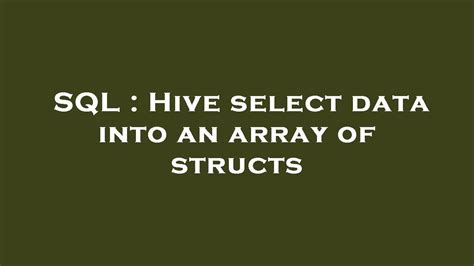When working with DataFrames in Apache Spark, selecting specific columns, also known as struct fields, is a fundamental operation. This can be particularly useful when you need to focus on a subset of data for analysis, processing, or visualization. The process involves understanding how to navigate through the DataFrame's schema to select the desired fields efficiently.
Navigating DataFrame Schema

To select struct fields, you first need to understand the structure of your DataFrame. Apache Spark DataFrames are essentially datasets organized into named columns. When a column contains a struct type, it means that column is composed of multiple fields, each of which can be of a different data type. You can think of a struct as a container that holds a collection of fields, similar to how a row in a relational database might contain multiple columns.
Understanding Struct Types
A struct type in Spark is essentially a complex data type that allows you to group related fields together. For example, if you have a DataFrame that represents people, a struct field named “address” might contain sub-fields like “street”, “city”, “state”, and “zip”. Understanding the hierarchy and naming of these fields is crucial for selecting them correctly.
| Field Name | Data Type |
|---|---|
| name | String |
| age | Integer |
| address | Struct |
| - street | String |
| - city | String |
| - state | String |
| - zip | String |

Selecting Struct Fields

To select a struct field from a DataFrame, you can use the select method provided by Spark DataFrames. This method allows you to specify the columns you want to select. When dealing with struct fields, you navigate through the hierarchy using the dot notation.
// Assuming 'df' is your DataFrame and you want to select the 'name' and 'street' fields
val selectedDF = df.select("name", "address.street")
This operation results in a new DataFrame (`selectedDF`) that contains only the specified columns. Note that the original DataFrame remains unchanged.
Using Select with Multiple Struct Fields
If you need to select multiple fields from a struct, you can specify each field individually using the dot notation. For example, if you want both the “street” and “city” from the “address” struct, you would do:
val selectedDF = df.select("name", "address.street", "address.city")
This approach allows for fine-grained control over which fields you select, enabling you to work with the specific data you need.
Key Points
- Understand the schema of your DataFrame to identify struct fields.
- Use the dot notation to select sub-fields from a struct (e.g., "address.street").
- The `select` method is used to choose specific columns, including struct fields.
- Multiple struct fields can be selected by specifying each one individually.
- Always verify the data types and field names to ensure correct selection.
Best Practices and Considerations
When selecting struct fields, it’s crucial to be mindful of the DataFrame’s schema and the data types of the fields you’re selecting. Incorrectly specifying a field name or data type can lead to errors. Additionally, consider the performance implications of selecting large numbers of columns or working with very large datasets.
Apache Spark provides powerful tools for manipulating and analyzing data in DataFrames, including the ability to select specific struct fields. By understanding how to navigate through the schema and use the dot notation, you can efficiently work with complex data structures and extract the information you need for your analyses.
How do I view the schema of my DataFrame in Apache Spark?
+You can view the schema of your DataFrame by calling the printSchema() method on your DataFrame object. This will display the structure of your DataFrame, including the names and data types of all columns.
Can I select struct fields dynamically based on some conditions?
+Yes, you can select struct fields dynamically by first identifying the fields you want to select based on your conditions, and then using the select method with the dynamically generated list of column names.
How do I handle missing values in struct fields when selecting them?
+Apache Spark provides several methods for handling missing values, including fillna(), dropna(), and replace(). You can apply these methods before or after selecting the struct fields, depending on your requirements.

